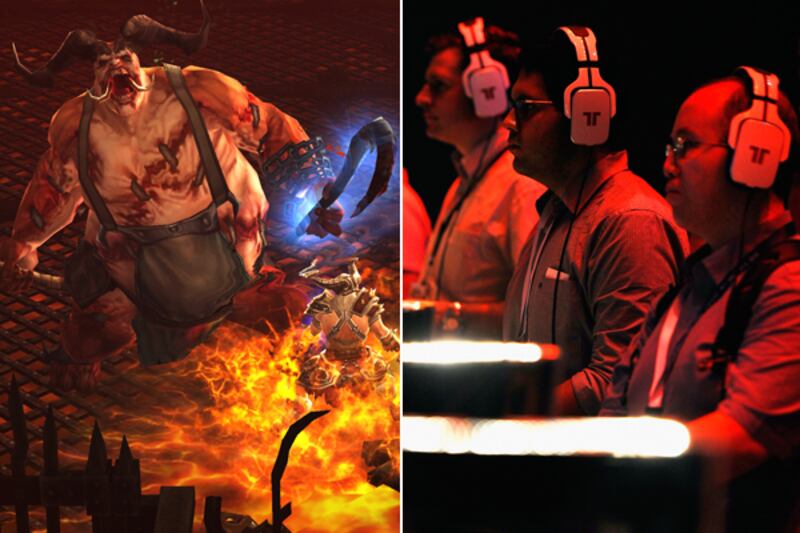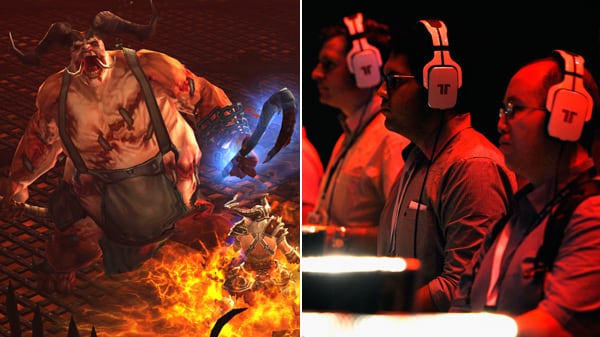“Crap,” I thought as I created my character in Diablo 3, the new hack-and-slash action role-playing game released last week by gaming behemoth Blizzard. Like all of Diablo’s fans, I’d been waiting for this for more than a decade. But my excitement was tinged with a little bit of dread. There was a very good chance this game would take over my life.
At least I knew what I was getting into. Even 12 years later, I still had vivid memories of staying up until the wee hours playing Diablo and Diablo 2, clicking endlessly in the hopes of finding just one more powerful item to make my character all the more formidable.
Sure enough, a week and a half after Diablo 3 had launched, I’d logged a shade more than 31 hours in the game, or about 3 hours a day.
It used to be impossible to explain to nongamers why Diablo is so freakishly engrossing, but the game’s appeal has now extended well beyond the nerd community, and countless innocent wives and girlfriends (and an increasing number of husbands and boyfriends) have temporarily lost their loved ones to the phenomenon.
So how does the game actually work? Here’s all you need to know: You enter a dungeon or a large outdoor area filled with monsters. You kill the monsters. When you do, “loot”—weapons and armor and gems—pops out. You sell or trade the loot and then kill more monsters. Repeat for 50 or 100 or 1,000 hours. Often you play with up to three other fellow Diablo addicts, teaming up to slaughter throng after throng of hell’s minions.
Most new games feature intricate plots and fully developed characters, but in Diablo 3, that’s all window dressing for the main event: killing wave after wave of monsters, over and over and over and over. And over.
It may sound boring and repetitive, but somehow it isn’t. In fact it’s all-consuming, and deeply Pavlovian. Decades ago, the behaviorists carefully studied which “reward schedules” were most likely to keep a rat coming back to a lever in hopes of getting another food pellet over and over and over. Now game designers do the same, and Blizzard is one of the masters of this art.

Even though I’m older and supposedly wiser, I was surprised by how quickly and fiercely my obsession took hold this time. On the day the game came out, I played for a few hours, then wrenched myself away to play tennis with a friend. During each point, I was able to banish Diablo 3 from my mind. But as soon as a point ended, the game would leap back into my head.
This has happened ever since. If I’m in the midst of a task, I can push the game to the background. But in idle moments, Diablo 3 tugs at me like an attention-starved toddler. If I play too much in a given day, my attempts to sleep will be interrupted by afterimages of the game (a phenomenon that researchers are starting to study).
The game is so addictive because it is designed to never end. There are plenty of great games—BioShock comes to mind—that bring some level of satisfaction when you complete them. Diablo 3 is not one of those games. It is designed to sate only partially, to forever hold out the tantalizing prospect of becoming ever more formidable. Yes, you get a brief surge of dopamine when you kill a big boss or complete a tough mission, but it’s never, ever enough. There’s always a reason to play for just a few more minutes.
There are other games like this, for sure, and obsessive “completionists” will spend hundreds of hours trying to find every item in every game. What makes Diablo 3 (and its predecessors) different is the extent to which the experience has been tweaked to enhance its addictiveness every step of the way. Other than a few bosses and cinematic cut scenes, almost everything in the game is randomized. This endlessly ramps up your appetite to play: you’re offered new and varying rewards every time you head out to kill monsters, and they’re varied enough to keep you coming back for more.
So is this a problem? I understand that those who play and make video games, having now dealt with decades worth of politically opportunistic pseudoscientific false accusations, are rightly vigilant about unfair criticism of the medium. But Diablo 3 is seriously addictive, and it would be foolish to gloss over that fact or jokingly discount it as a quirky side-effect of a well-designed game. (And it is very well-designed; though the plot and writing are forgettable, in general Diablo 3’s production values are off the charts.) There are people who are going to play Diablo 3 for 40 or 50 hours a week, just as there are already people who play World of Warcraft (another Blizzard masterpiece) at least that much.
We tech-savvy types can bellyache all we want about technophobia, about the ability of hysterical demagogues to scare gullible parents into thinking there is a direct link between gaming and violence or mental disorder, but a lot of people do get seriously addicted to a game like this.
When it comes down to it, Diablo 3’s appeal relies on a very simple, ancient sort of addiction. Shouldn’t that affect how we view it? In short, is “addictive” the same thing as good?






